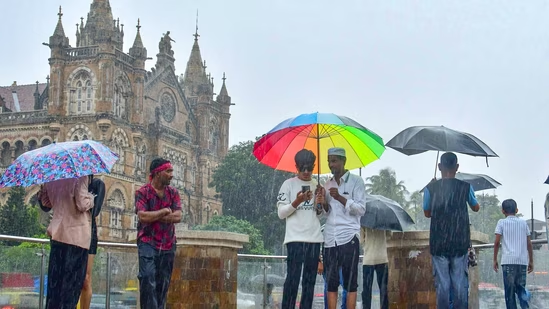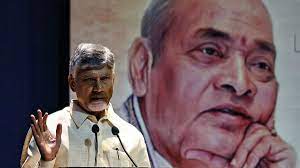Mumbai Rains Intensify – IMD Issues Red Alert for Raigad and Thane, Orange Alert for Pune
As the monsoon surges across Maharashtra, the India Meteorological Department (IMD) has issued a red alert for Raigad and Thane districts, forecasting extremely heavy rainfall over the coming 24 to 48 hours. Mumbai, the state’s financial capital, is already grappling with waterlogged streets, traffic snarls, and ongoing high tide warnings, with forecasters predicting continued downpours across the region.
According to the IMD’s bulletin, the red alert — the highest level in its three-tier warning system — indicates a “take action” level of emergency preparedness, warning of very heavy to extremely heavy rainfall exceeding 204.4 mm in a 24-hour period. Thane and Raigad, both located within the Mumbai Metropolitan Region (MMR), are expected to receive intense spells that may cause flash floods, landslides, and disruptions to transport and civic life.
Simultaneously, an orange alert has been sounded for Pune, Palghar, Ratnagiri, and other districts, signifying the likelihood of heavy to very heavy rainfall ranging from 115.6 mm to 204.4 mm. The orange alert falls under the “be prepared” advisory, urging local authorities to remain vigilant. Pune, in particular, is expected to witness intense showers that could overwhelm its drainage infrastructure, prompting a review of flood mitigation strategies.
The warnings come amid a particularly active monsoon spell over the Konkan coast, driven by strong westerly winds from the Arabian Sea. The IMD has noted a significant increase in moisture incursion and convective activity across coastal Maharashtra. Mumbai, already recording above-normal rainfall this season, remains under surveillance for potential weather-related emergencies.
Civic authorities across affected districts have sprung into action, activating emergency response teams and pre-positioning pumping equipment in low-lying areas. The Brihanmumbai Municipal Corporation (BMC) has intensified desilting operations, issued alerts through social media, and deployed staff to monitor vulnerable zones such as Hindmata, Sion, and Kurla. Schools and colleges in certain rain-hit areas were advised to remain shut as a precautionary measure.
Local trains — Mumbai’s lifeline — have reported delays and disruptions, especially on the Central and Harbour lines. Suburban rail traffic has become increasingly erratic with water-logging on tracks in areas like Thane and Kurla. Meanwhile, commuters are advised to check official updates before venturing out.
Beyond infrastructure woes, the continuous downpour is also impacting daily life in the form of traffic congestion, flight delays, and power outages. Several housing societies in Navi Mumbai and Kalyan reported water seepage and short circuits, while emergency services received numerous calls related to tree falls and minor flooding.
The Maharashtra State Disaster Management Authority (MSDMA) has instructed district collectors to remain on high alert and ensure that evacuation shelters, medical aid, and emergency logistics are in place. Authorities are coordinating with the National Disaster Response Force (NDRF) to pre-deploy personnel in areas marked as high-risk.
Environmentalists have emphasized the long-term implications of urban flooding and have urged the state government to accelerate flood mitigation projects, particularly in sensitive zones like the Mithi River basin and Vasai Creek. The existing stormwater drainage capacity in Mumbai, designed for a much lower rainfall intensity, is increasingly being tested as climate change leads to erratic and extreme weather patterns.
Despite the adverse conditions, the IMD has provided some hope, suggesting a possible reduction in rainfall intensity by the end of the week. However, the prevailing synoptic conditions indicate that sporadic heavy spells could continue into the next week, particularly during late evenings and early mornings.
In the coming days, all eyes will remain on the IMD’s next set of advisories, as Maharashtra braces for another wave of nature’s fury. The red alert serves as both a warning and a reminder of the increasing vulnerability of urban centers to climate volatility. As monsoon 2025 unfolds, the urgent need for sustainable infrastructure and proactive disaster preparedness has once again taken center stage.
As the red and orange alerts ripple through Maharashtra’s administrative machinery, the Mumbai Metropolitan Region (MMR) finds itself at the intersection of nature’s fury and infrastructural fragility. From municipal authorities to traffic police and disaster response units, a coordinated but stretched response system is navigating the daunting challenge of keeping the city functional amid relentless rains.
Mumbai’s urban topography — a mosaic of high-rises, slums, clogged nullahs, and concretized terrain — exacerbates the impact of monsoonal flooding. In districts like Thane and Raigad, where development often outpaces drainage upgrades, the situation is even more precarious. Experts have pointed out that natural floodplains and mangrove buffers have been gradually replaced by construction, severely undermining the region’s ability to absorb intense rainfall.
On July 14, water levels in several creeks and rivers, including the Ulhas and Amba rivers, were reported to be rising rapidly. The Irrigation Department has been monitoring these water bodies closely, concerned about the potential for spillage from local dams. In some rural pockets of Raigad, authorities began issuing early advisories to farmers and villagers to move livestock and essentials to higher ground, signaling the first stages of localized evacuation readiness.
The situation in Pune, under orange alert, presents a different but equally concerning picture. With its hilly terrain, narrow roads, and expanding urban sprawl, Pune has struggled in past years with waterlogging and flash flooding in localities such as Baner, Kothrud, and Hadapsar. The Pune Municipal Corporation (PMC) has deployed additional pumps and activated its emergency helpline system, but officials acknowledge that heavy rainfall could strain the city’s existing infrastructure, especially in older parts of town.
Meanwhile, educational institutions, especially in the red-alert zones, have begun shifting to online modes temporarily. Some schools in Thane and Raigad preemptively announced closures, while universities delayed examinations scheduled for the week. While parents welcomed the move, it also raised questions about the larger need for a monsoon contingency academic calendar — something that urban planners and education boards may need to seriously consider in the years ahead.
Citizens across Mumbai and neighboring districts continue to rely on real-time updates from the IMD and civic authorities. Social media platforms have emerged as a critical communication tool, with the BMC, NDRF, and Maharashtra Disaster Management Authority posting frequent advisories, helpline numbers, and area-specific warnings. In many cases, citizen groups, housing societies, and local NGOs have stepped in to assist vulnerable populations — especially the elderly, differently-abled, and slum dwellers — with food packets, umbrellas, torches, and dry clothes.
Yet, the ground reality in several rain-affected pockets remains grim. In the slums of Mankhurd, Govandi, and Nalasopara, residents waded through knee-deep water, some using buckets to manually scoop water out of their homes. In parts of Kalyan and Ambernath, power outages lasting several hours were reported, particularly in buildings that still rely on overhead transformers and outdated wiring systems. Medical emergencies, particularly related to waterborne diseases like leptospirosis and dengue, are also expected to rise in the aftermath.
Healthcare authorities have already been instructed to stock up on essential medicines and deploy mobile health vans in remote and flood-prone zones. The state’s Public Health Department is also expected to launch awareness drives regarding monsoon hygiene, clean drinking water practices, and preventive care — especially for those residing in low-income settlements.
On the transportation front, Mumbai’s roads continue to bear the brunt of the weather, with potholes and flooding leading to traffic snarls lasting hours. The Eastern Express Highway, Western Express Highway, and major arterial roads like SV Road and LBS Marg reported slow-moving traffic throughout the day. Cab aggregators saw longer wait times and surge pricing, while the Mumbai Metro, in contrast, reported stable operations and increased ridership — a silver lining amid the chaos.
The aviation sector was not immune either. At Chhatrapati Shivaji Maharaj International Airport, several flights were delayed due to poor visibility and slippery runways. Passengers faced long queues at check-in counters and rescheduling hassles. Airlines were urged by the Directorate General of Civil Aviation (DGCA) to ensure that rain preparedness protocols, including emergency ground handling and runway inspection, were strictly followed.
For residents and officials alike, the red and orange alerts have underscored a sobering reality: monsoon is no longer just a season — it is a litmus test of urban governance, climate resilience, and public responsibility. As Mumbai continues to expand vertically and horizontally, the demand for a more robust monsoon response framework — one that integrates environmental science, engineering, public health, and technology — has never been greater.
The next few days are expected to be crucial. While the IMD has indicated a potential easing of conditions toward the weekend, unpredictable convective rainfall cells can still trigger localized downpours. Citizens have been advised to avoid unnecessary travel, remain indoors during peak rainfall hours, and keep emergency kits — including clean water, batteries, phone chargers, and essential documents — within easy reach.
The spirit of Mumbai, often praised for its resilience, is once again being tested by the monsoon. Whether this resilience continues to hold, or cracks under pressure, will depend not just on rainfall intensity but on the depth of the city’s preparedness, compassion, and collective will.
While citizens battle knee-deep water and authorities scramble to keep essential services operational, the larger issue looms in the background—the widening gap between policy intentions and ground-level execution. For all the detailed disaster management plans that are prepared annually by urban local bodies, the continuing monsoon disruptions point to persistent systemic shortcomings.
Experts argue that despite having a detailed Monsoon Preparedness Plan, the implementation often remains reactive rather than proactive. Drain desilting, for example, is supposed to be completed before the arrival of the first monsoon showers. Yet every year, reports emerge of incomplete work or silting reaccumulating in low-lying areas due to poor monitoring. As a result, places like Hindmata in Mumbai or Naupada in Thane become annual flood hotspots.
One of the recurring criticisms leveled at Maharashtra’s urban planning departments is the slow pace of adopting climate-resilient infrastructure. Many drainage systems in Mumbai and neighboring cities still follow the old British-era designs, built for handling rainfall of up to 25 mm per hour — far below the current intensity levels being recorded. The failure to upgrade stormwater systems in line with climate data has left the city vulnerable to backflow flooding and sewage overflow.
Similarly, mangrove deforestation and encroachment on natural floodplains have compounded the city’s problems. In Raigad and Navi Mumbai, several wetlands and salt pans have been converted into residential zones, many of which now witness seasonal flooding. While courts and environmental bodies have passed rulings in favor of wetland protection, enforcement on the ground has been lackluster at best.
Urban planners and hydrologists are increasingly calling for a fundamental shift in how cities are designed. “We need to move from concrete-based flood protection to nature-based solutions,” says Dr. Aniruddha Kale, an environmental engineer affiliated with the Indian Institute of Technology, Bombay. “Rejuvenating rivers, protecting mangroves, creating rain gardens, and building sponge parks can help absorb excess rainwater and reduce flood pressure on existing infrastructure.”
The issue also extends into housing policy. In cities like Mumbai, where land is scarce and the population density is among the highest in the world, thousands reside in unauthorized slums built along riverbanks and drain canals. These communities face the brunt of monsoon flooding, often losing their possessions and facing health crises year after year. Yet relocation efforts have moved at a snail’s pace, bogged down by legal battles, political opposition, and a shortage of viable rehabilitation projects.
To that end, the Maharashtra government’s recent push for cluster redevelopment and vertical resettlement under the Development Control & Promotion Regulations (DCPR) is seen as a positive step. However, critics warn that simply moving people to high-rises without addressing issues of drainage, sewage, and solid waste management could lead to vertical slums rather than sustainable communities.
Parallel to infrastructure and housing concerns is the issue of data transparency and early warning systems. While the IMD’s forecasts have significantly improved in accuracy and timeliness, there is still a gap in hyperlocal data dissemination. Not all citizens have access to real-time rainfall intensity updates, especially those in non-English speaking or low-income demographics. Civic apps, SMS alerts in local languages, and integration with local news networks can play a vital role in bridging this communication gap.
Further, inter-agency coordination remains a thorny issue during emergencies. In the event of flooding, multiple agencies — the BMC, Maharashtra State Road Development Corporation (MSRDC), police, NDRF, fire brigade, BEST, and local NGOs — must act in tandem. But overlapping jurisdictions, lack of protocol synchronization, and bureaucratic silos often slow down response times and duplicate efforts.
One bright spot has been the increased use of geospatial mapping and remote sensing technologies in flood prediction and water-level monitoring. Mumbai’s Disaster Management Unit has begun collaborating with the Indian Space Research Organisation (ISRO) and other institutions to create dynamic flood maps that can assist in predictive modeling. However, these tools are still in their nascent stage and require significant investment, training, and public accessibility to be truly impactful.
Beyond the infrastructure and technological aspects, the monsoon crisis in Maharashtra has also sparked a renewed debate on citizen responsibility and civic sense. Every year, clogged drains are worsened by plastic waste, construction debris, and improper garbage disposal. Public transport is overwhelmed not only by rain but by crowding, littering, and neglect of maintenance. Community-driven cleanliness campaigns, housing society waste audits, and rainwater harvesting mandates are steps that must go hand-in-hand with governmental efforts.
As the rains continue and more alerts are expected to be issued in the coming week, the city stands at a crossroads. Will this be yet another year of temporary fixes and ceremonial reviews, or will the 2025 monsoon be a turning point that forces stakeholders to embrace long-term resilience?
In the words of noted urban planner Dr. Megha Deshpande, “Rainfall is not the enemy — poor planning is. Unless we stop treating floods as annual natural disasters and start treating them as failures of governance, nothing will change.”
The coming parts of this series will dive deeper into real-time stories from the ground — the unsung workers keeping the city running, the families hit hardest by flooding, and the climate science behind increasingly erratic monsoons in western India.
While headlines scream of red alerts and record-breaking rainfall, it’s on the ground — in the bylanes of Mumbai, Thane, and Raigad — that the true cost of the monsoon reveals itself. Away from weather bulletins and government briefings, everyday citizens continue to endure a punishing routine of flooding, power cuts, lost wages, and sleepless nights.
In the slum cluster of Dharavi Transit Camp, 42-year-old Radha D’souza stood in ankle-deep water outside her one-room kitchen, holding her toddler on her hip. “Every year it floods. The gutter outside overflows into the house,” she says, pointing to the plastic buckets lined up along her wall, used to catch the seepage leaking from the ceiling. Her husband, an auto driver, has been unable to work for three days. “Who will sit in a rickshaw in this rain? And if we stay home, we don’t earn. It’s that simple.”
Just a few kilometers away in Thane’s Kalwa region, a group of sanitation workers from the municipal corporation had been working nonstop since 4 a.m. clearing debris from a choked nullah. “We are used to the smell,” says 29-year-old Suresh Pawar, “but not the abuse. People throw everything into the drains — diapers, plastic, even furniture.” His colleague nods as they drag out a sack filled with discarded construction rubble. “One storm and the whole system collapses. Then they blame the workers.”
For these men and women, rain is not poetic — it’s exhausting, hazardous, and poorly compensated. While some are provided with raincoats, most buy their own. Footwear is often mismatched or broken, and gloves, when available, are rarely waterproof. Yet, without them, roads don’t drain, and streets don’t clear. In many ways, they are the backbone of the city’s monsoon survival strategy — underpaid, undervalued, and mostly invisible.
In Raigad district, the red alert has triggered panic among residents still haunted by memories of the catastrophic 2021 landslide in Taliye village, which claimed dozens of lives. “Whenever there’s a red alert now, we stay up all night,” says Mahesh Patil, a farmer in Mahad. “Our phones buzz with warnings, and every thunderclap feels like it might bring the mountain down.”
His wife, Sheetal, has packed an emergency bag — torch, water bottle, medical supplies, and their land documents. “We’ve lived here all our lives,” she says, “but each monsoon feels like we are gambling with fate.” The local panchayat has distributed sandbags and tarpaulins, but residents say more needs to be done, including permanent relocation from the most landslide-prone zones.
Meanwhile, in Pune’s Katraj area, which falls under the IMD’s orange alert zone, housing societies are struggling with clogged basements and electrical faults. In a multi-story building off Sinhagad Road, 65-year-old Shirish Kale was seen trying to bail out water from his parking lot with a garden bucket. “We told the builder about the drainage issue last year, but he blamed it on ‘natural causes’,” he said. “Now my car is half-submerged, and the elevators have stopped working. Is this what we call urban India?”
Despite the chaos, stories of quiet heroism continue to shine through the gloom.
In Dombivli, a group of college students — self-organized under the banner “Rain Relief Mumbai” — distributed hot tea and biscuit packets to traffic policemen standing in torrential downpours near the railway station. “They are out there every day, without umbrellas, managing insane traffic,” said 20-year-old Shivangi Mehta, one of the volunteers. “It’s the least we could do.”
In Kurla East, a community kitchen run by local residents cooked and distributed over 700 meals in one day to those stranded in waterlogged chawls. “Many families here work as housemaids, daily-wage laborers, or helpers in shops that are now shut,” says Irfan Sheikh, one of the coordinators. “If they can’t go to work, they can’t eat. It’s that direct.”
Such acts of compassion are not rare in Mumbai — they are, in fact, part of its seasonal rhythm. But as these episodes repeat year after year, many wonder: why should resilience always come at the cost of normalcy? Why must the poor be heroic just to survive?
In conversations across neighborhoods — whether with shopkeepers in Borivali, vegetable vendors in Mumbra, or BEST conductors driving through flooded roads — a common refrain echoes: “Rain is not the problem. The system is.”
To many, the red and orange alerts issued by the IMD may as well be ritual markers of another difficult month ahead. But for those wading through flooded bedrooms, or holding back tears over ruined textbooks, these alerts signal much more than weather — they signal abandonment, frustration, and an exhausting wait for change.
As Part 5 of this series will explore, the youth of Maharashtra — particularly in cities like Mumbai and Pune — are emerging as a crucial voice in the climate conversation. From community mapping to rainwater harvesting and digital activism, a new generation is stepping in where the system is faltering.








